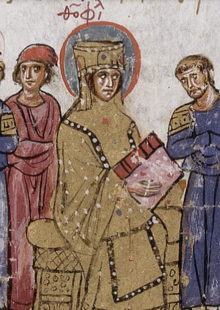
Back Teodora II AN ثيودورا (زوجة ثيوفيلوس) Arabic ثيودورا (وصى العرش) ARZ Теодора II Bulgarian Teodora l'Armènia Catalan Theodora II. Czech Theodora II. German Θεοδώρα (9ος αιώνας) Greek Teodora la Armenino Esperanto Teodora (esposa de Teófilo) Spanish
| Theodora II | |
|---|---|
| Augusta Empress of the Romans | |
 Empress Theodora as depicted in the 12th century Madrid Skylitzes | |
| Byzantine empress regnant[1] or regent[2] | |
| Rule | 20 January 842 – 15 March 856 |
| Predecessor | Theophilos |
| Successor | Michael III (alone) |
| Co-rulers | Michael III and Thekla |
| Byzantine empress consort | |
| Tenure | 5 June 830 – 20 January 842 |
| Coronation | 5 June 830 |
| Born | c. 815 Ebissa, Paphlagonia |
| Died | c. 867 (aged c. 52) |
| Spouse | Theophilos |
| Issue | Constantine Thekla Anna Anastasia Pulcheria Maria Michael III |
| Dynasty | Amorian dynasty (through marriage) |
| Father | Marinos |
| Mother | Theoktiste Phlorina |
| Amorian dynasty | ||
|---|---|---|
| Chronology | ||
|
||
| Succession | ||
|
||
Theodora[a] (Greek: Θεοδώρα; c. 815 – c. 867), sometimes called Theodora the Armenian[7][8] or Theodora the Blessed,[9] was Byzantine empress as the wife of Byzantine emperor Theophilos from 830 to 842 and regent for the couple's young son Michael III, after the death of Theophilos, from 842 to 856. She is sometimes counted as an empress regnant, exercising power in her own right, rather than just a regent.[b] Theodora is most famous for bringing an end to the second Byzantine Iconoclasm (814–843), an act for which she is recognized as a saint in the Eastern Orthodox Church. Though her reign saw the loss of most of Sicily and failure to retake Crete, Theodora's foreign policy was otherwise highly successful; by 856, the Byzantine Empire had gained the upper hand over both the Bulgarian Empire and the Abbasid Caliphate, and the Slavic tribes in the Peloponnese had been forced to pay tribute, all without decreasing the imperial gold reserve.
Possibly of Armenian descent, Theodora was born into a rural family of traders and military officials in Paphlagonia. In 830 she was selected by Euphrosyne, step-mother of the emperor Theophilos, as a candidate in a bride-show for the young emperor. After being chosen by Theophilos she was crowned empress on 5 June 830. Theophilos was an iconoclast, who opposed the veneration of icons; it is unclear how aware he was that Theodora was an iconophile. The couple had seven children and Theodora was a loyal participant in imperial affairs and ceremonies, but she continued to secretly venerate icons throughout her husband's reign. Theophilos died of dysentery on 20 January 842, probably younger than 30. On his deathbed, he named Theodora as regent for their two-year-old son Michael III and designated a selection of advisors to assist her. The most prominent of these advisors was the logothete and eunuch Theoktistos, who would become a close confidant of Theodora.
Theodora proved to be fully capable of governing the empire. Though only in her late twenties, she led well and inspired loyalty, was surrounded by experienced officials, and had no obvious rivals. The reintroduction of icon veneration was made without much issue, though the Paulician heretics in eastern Anatolia were ruthlessly suppressed on Theodora's orders. Without the need of much military action, she managed to safeguard the empire from attacks by the Bulgarian rulers Presian and Boris I through diplomacy. The Byzantine sack of the city of Anazarbus in Cilicia largely ended the Arab threat for the near future. As Michael III grew older, he feared that Theodora meant to follow in the footsteps of Empress Irene and depose him in order to rule alone. Angered by Theodora's refusal to allow him to choose his own wife, Michael recalled her brother Bardas from exile, and with him assassinated Theoktistos in November 855. Theodora was enraged at Michael and the other conspirators for several months, before Michael, who was unable to placate his mother, deposed her on 15 March 856 and became sole emperor. Theodora continued to live in the imperial palace until 857 or 858, when she was expelled and confined to a convent in Gastria alongside some of her daughters. She may have been released from the convent around 863 and allowed to take some form of ceremonial role. She died shortly after Michael III was murdered by his friend and co-emperor, Basil I.
- ^ ODB, p. 2037.
- ^ Theodora in the Encyclopædia Britannica
- ^ Karagianni 2013, pp. 15, 22.
- ^ a b Elton 1825, p. 304.
- ^ Karagianni 2013, p. 22.
- ^ Marciniak & Nilsson 2020, p. 386.
- ^ Baumstark 2011, p. 128.
- ^ Bussell 1910, p. xiii.
- ^ Greenwalt 2002, p. 344.
- ^ Garland 1999, p. 102.
Cite error: There are <ref group=lower-alpha> tags or {{efn}} templates on this page, but the references will not show without a {{reflist|group=lower-alpha}} template or {{notelist}} template (see the help page).